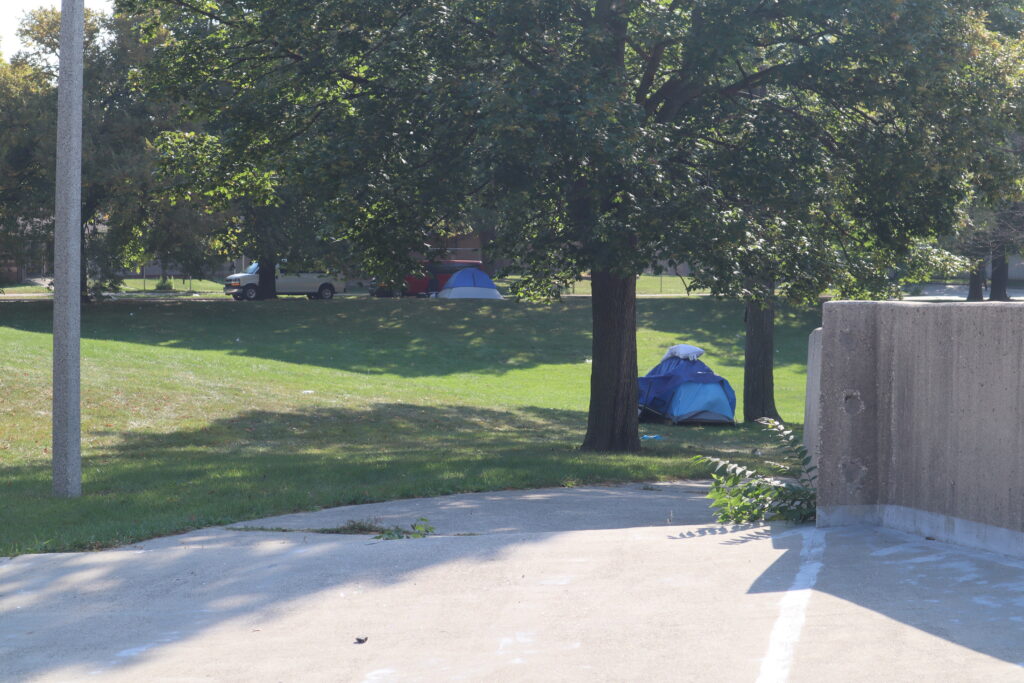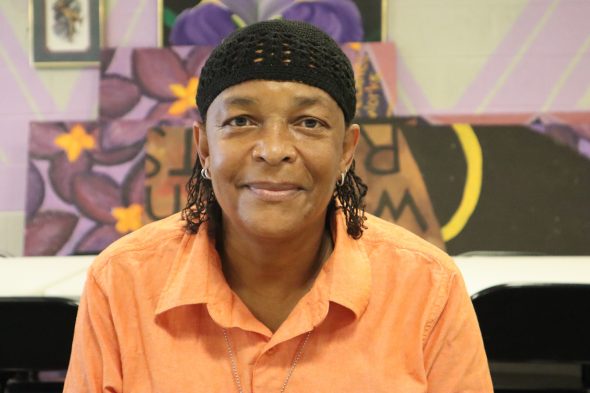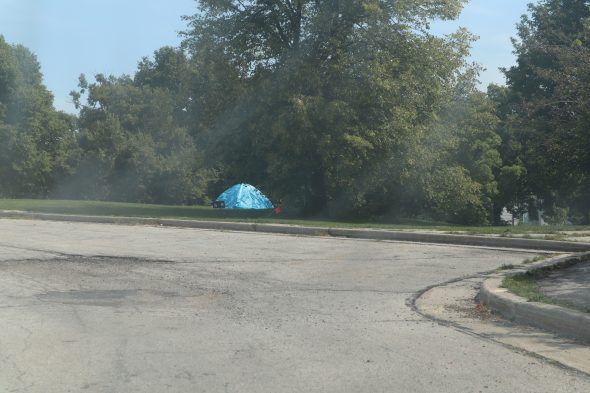King Park Tent Community Shows City’s Housing Struggles
Despite some successes, housing remains a major challenge in Milwaukee.

Clusters of tents can be found in King Park, though the number varies depending on the day. Photo by Isiah Holmes/Wisconsin Examiner.
“There’s way more homeless out here,” Willie T., a 63 year old man who lives, unhoused, near King Park told Wisconsin Examiner. Willie didn’t want his last name published, but still offered his insights on what life is like for those living in a growing tent community in King Park on Vliet Street. Ranging from 16-20 tents, depending on the day, it has steadily grown since 2019.
Although many members of the King Park tent community mingle among themselves, Willlie does not. He prefers to set up his nightly spot away from the park and other people. Remaining aware and being careful are paramount when you’re living on the street, he says. Even so, Willie stresses that “all homeless people ain’t bad people.”
Eric Collins-Dyke, assistant administrator of Supportive Housing and Homeless Services for Milwaukee County, feels Milwaukee’s unhoused population is more spread out these days. “Whenever an encampment pops up we generally know right away,” Collins-Dyke told Wisconsin Examiner. “Last year King Park got pretty large towards the back-end of summer, through October and November. I want to say there’s about 45 individuals there.” During 2020 Eric says hotel space became a “wonderful resource,” for the county’s efforts due to COVID-19. Once winter came, there didn’t appear to be anyone left living in the park. As 2021 went on, however, the park saw the population of unhoused folks begin to rise again.
In 2019, controversy erupted over a large encampment of homeless Milwaukeeans living under a downtown highway overpass. The encampment gained the moniker “Tent City,” and functioned with a degree of autonomy. The community itself consisted of five distinct clusters of tents which functioned as neighborhoods. Conflicts between the groups were minimal, and residents kept the area clean and orderly. Showers and laundry could be found a mile away at the Milwaukee Rescue Mission, and there was free wi-fi nearby. Supplies and food were regularly donated by passersby and aid organizations.
Eventually the residents of Tent City were housed or re-located. Collins-Dyke points out that housing is “such a dignified resource in terms of having your own heat, place to shower, clean bed, three meals a day, all those things.” He praised the hotels, which became part of the county’s strategy for addressing emergency housing last year. Collins-Dyke told Wisconsin Examiner that the hotels are a resource “I wish we had in perpetuity here in the community, to be able to offer to people living outdoors.”
In addition to the county’s outreach teams, groups like Street Angels conduct their own nightly outreach missions. Through these, King Park’s inhabitants are provided new tents, cell phones, wi-fi hotspots, and other resources. All of that, however, doesn’t overcome the raw struggle of living outside. A few months ago, the park experienced an uptick in its homeless population. “At the height probably three or four weeks ago, there was about 25 individuals staying there,” Collins-Dyke noted. Although, of course, the numbers fluctuate.
Advocates say there are growing numbers of homeless people in Milwaukee. Eva Welch, co-founder and director of Street Angels, told Urban Milwaukee that on average her outreach teams see up to 150 people per night throughout the city. Organizers from the Milwaukee Autonomous Tenants Union (MATU) have also encountered unhoused people during their own eviction-focused outreach. One woman the MATU encountered during a Cancel the Rents action said she was freshly evicted and living in her car.
An observed increase in homelessness makes some people question the trend reported by the Milwaukee Continuum of Care’s Point In Time Count. Done on one night in late January annually, the count acts as a kind of snapshot of the known unhoused population. In January of this year the count of folks who remained unsheltered was 17. The same group counted 87 in 2020 and 114 in 2019. But the year 2020 also saw a spike in the number of people in emergency shelters to 704, up from 589 in 2019.
Of course, unhoused people are more than just numbers on an annual spreadsheet. “It’s tougher for the women out here,” said Willie T. While some may see the park as a safe place, others may only see a source of vulnerable people to take advantage of. One woman in her early 60s walked past to say hello to Willie. “I’m getting ate up by bumble bees and mosquitoes everyday,” she said, “It’s no way to live.”
The late summer storms Milwaukee experienced which knocked down over 600 trees disrupted the King Park tent community. “When it rained I had to crawl my way out of it,” Willie’s neighbor said. Willie added, “You gotta get up under something, an overhang.” Willie wondered why once the storms ended, “you can come pick up the trees but not the people.” Many King Park residents want to get back on their feet. Willie said he’s currently waiting to qualify for disability payments, but is willing to work if need be. “Just put me up in a studio somewhere,” he said, stressing that he doesn’t want much. As far as Dave could tell there were no children living in the tent community, though there were several working people. Collins-Dyke echoed this observation, saying he has encountered many people living in King Park who work temp jobs.
Collins-Dyke called employment “the issue that kind of shadows the homelessness issue.” He stressed that, “I would love to see not only more affordable housing, but more employment opportunities as well. It’s desperately needed.” The city is currently hashing out how it plans to wield a budget augmented by federal American Rescue Plan Act (ARPA) funds. Tom Barrett, Milwaukee’s departing mayor, included over $4 million for affordable and sustainable housing projects in the proposed budget. In the meantime, however, people remain unhoused and outdoors in King Park.
Split between compassion and deterrence
For the adjacent Dr. Martin Luther King Jr. Community Center, dealing with some of the unhoused folks at the park has been a struggle. During conversations with residents of the tent community, several mentioned that they used to be able to charge their phones on the outside of the community center building. A couple of months ago, however, that source of power was cut. They wondered why they couldn’t get portable bathrooms, or more access to resources like water. To them, it felt as though their lives were being made harder intentionally.

Valdemetreia McCollum, director of the Dr. Martin Luther King Jr. Community Center. Photo by Isiah Holmes/Wisconsin Examiner.
Valdemetreia McCollum, the center’s director and a 13-year veteran of the facility, said these have been difficult choices to make. “We haven’t always had a major homeless problem,” she told Wisconsin Examiner. “It’s just that over the last several years, especially during COVID, that it has picked up. The issue with it is not only has the homeless population picked up, the aggressiveness of some of them has changed. And it’s escalated. We’ve had some dangerous moments, and some uncomfortable moments. Some of those moments were what led to the decision to try to move them into housing — but more importantly, move them away from the building.”
McCollum said human waste can be a recurring problem. At times the waste needed to be cleaned up by the center’s staff. Usually there are only about three people in the building, including McCollum, during the day. “The issue that you mentioned with them being able to charge their phones in the stage area in the back of the building, not only were they charging their phones and stuff but it became a dumping area for the bathroom,” she said. “So we tried to think of different ways that we could combat that, because we have to clean that up. So one of the things that we did do was try to figure out a way to not have them congregate up against it.”
McCollum added that, “It’s a difficult situation if you are a compassionate person, which I am. Because I always say, ‘but for the grace of God there go I.’ However, I still have a responsibility to protect the people that utilize this building and the children in this building.” McCollum particularly worries about what the children in the summer programs may see. McCollum realizes that there are serious and obvious mental health problems involved. Over time, she says, the community center has had to close itself off from the unhoused folks just outside. Ultimately, McCollum feels that the best thing they can do for folks in the park is provide them the dignity of housing.
The King Park community center isn’t the only institution struggling with this balancing act. Officials in the city of Wauwatosa say an ordinance the city passed imposing fines for people standing at intersections asking for money has worked, deterring panhandling on the streets. Wauwatosa residents have made fewer complaints to police involving people asking for money along the roadside this year. Wauwatosa officers have been handing out referral sheets with information on six nearby shelters. But Collins-Dyke says this hasn’t solved anything. “You may not see people on the medians anymore, but the problem has not changed one bit,” he told the Milwaukee Journal Sentinel. “The issues that those folks are dealing with — whether it’s literal homelessness, general housing insecurity, mental health, unemployment — are all still there.”
McCollum hopes that solutions are found which get King Park’s lingering residents in housing before the winter comes. “I don’t want to put forth anything that gives them the idea that I think that it’s OK for them to live in a tent outside,” said McCollum. “I don’t want to provide a sink and a porta-poddy outside for them to think that it’s OK for them to live out there. I want them to understand that it is my concern, it is my heart, it is my prayer that we get them under a roof where they get a meal, where they can sleep in a bed, where they can take a shower, where they can do all the things necessary for them to survive and be healthy individuals.”
Sometimes McCollum sees folks who’ve been housed return to the park. “You are a human being,” she says. “You are one of one of God’s children. You deserve to be in a house. You deserve to be in some enclosed environment with a bed, with a shower, with the medicine that you may or may not need.”
The King Park tent community and Milwaukee’s housing struggles was originally published by the Wisconsin Examiner.























Allow homeless people to live on the playing field inside the Milwaukee Brewers baseball stadium November through March.
Let the homeless have total access to the stadium, the rest rooms, water, the locker rooms, and showers during cold weather months until the politicians in $10,000 business suits come up with a better plan.
NWK’s idea above is not so bad, except Brewer Stadium is far from the social service agencies that currently support much of the homeless population. On the other hand, Fiserv Forum is centrally located, and I recall the public forked over $250 million for its construction.
I know that grocery stores and many other private venues are required to provide public bathrooms. Why can’t Fiserv Forum do the same, along with access to water and showers? It certainly would put needed pressure on our leaders, both government and business, to work towards a solution to this crisis.
The assumption is that these homeless people are U.S. citizens. What if we find these tent cities are composed of migrants who have simply crossed our international border without authorization or reporting?
Something to think about.
@sbaldwin001 – I surveyed the Milwaukee and Menomonee for a few years when I worked for the Wisconsin DNR. Homeless people lived along the rivers, under bridges, in sleeping bags, and in their vehicles (if they had vehicles).
Homeless people that had vehicles would drive around at night and sleep during the day in order to avoid police and overnight parking tickets.
I didn’t see any homeless migrants. But I did see a lot of suffering that haunts me to this day. A friend of mine belonged to a church group that fed homeless men and women that lived under the 27th street viaduct.
There are a lot of homeless people that live on the Menominee River near the baseball stadium. You can see them pushing carts full of metal to the recycling center on Canal street.
Wall Street busted all of our labor unions. Then they outsourced 95% of our good paying Milwaukee jobs out of the country with the help of Schumer, Pelosi, Obama, Clinton, Bush, Reagan, and Biden. Then they cut our wages, our benefits, and charged us $15,000 every year for health insurance that covers nothing. That’s the reason why people are homeless in Milwaukee.